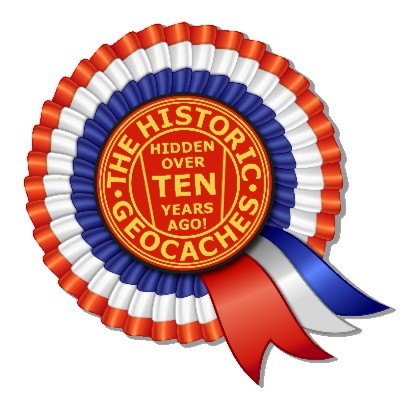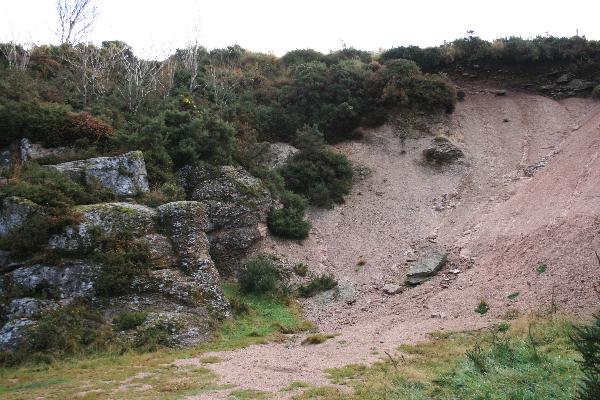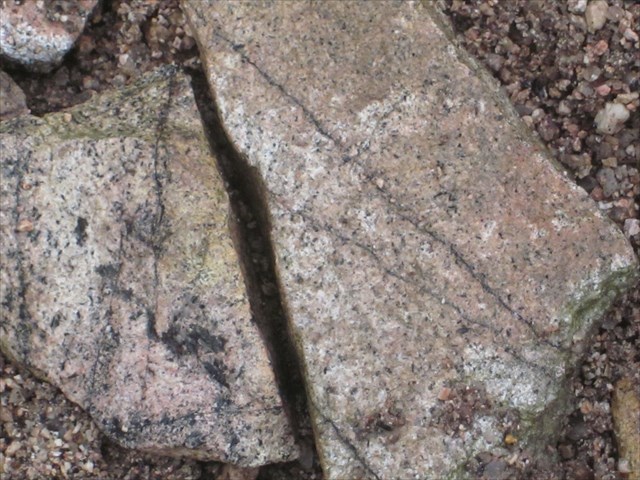
Prior to the arrival of the granite the area of Dartmoor had consisted of rocks and sediments formed during the Devonian period ( 400 - 360 million years ago) and the Carboniferous period ( 360 - 280 million years ago). During the Devonian period the area had been part of a large flood plane in which sediments were laid down which we now see as slates and shales. During the Carboniferous period the area was under a warm sea and the sediments became what are now limestones and sandstones.
The granite of Dartmoor was forced up from below about 290 million years ago towards the end of the Carboniferous period. The granite welled up as molten rock in the southern half of Dartmoor and flowed northwards. It did not break the surface and solidified while still underground. In time the material above the granite was eroded away leaving it exposed. Similar up-wellings occurred along a line extending from Dartmoor to the Scilly Isles, including what are now Bodmin Moor and St Austell Moor.
Granite consists mainly of quartz, mica and feldspar. It also contains some of the native rocks both in solution and as particles and larger lumps. The quality and colour of granite vary with rate of cooling and the amount and type of the absorbed materials.
The feldspar in the granite has decayed in some places. The process of decay may have started as the rock cooled and is continuing today. The feldspar softens (kaolinises) to form china clay (kaolin) which remains in situ mingled with the mica and quartz. This kaolinised granite, often known as growan, is much softer than the original and is easily eroded. In those areas where the granite was free of impurities the kaolin is white and is commercially very valuable. In the clay extracting areas around Lee Mill and Wotter the decayed granite is dislodged using water cannons. The quartz and mica are separated from the slurry by gravity and the kaolin is recovered by drying. The kaolin extracted represents about 12% of the original granite.
The small quarry at Two Bridges was used to provide road building materials during the turnpike building period, the early 19th century. It provided easily broken partially rotted granite and growan suitable for the road building techniques of the time.
The quarry is now used as a car park (free) and access is open to the public all year round. Permission to enter the site is not required.
The quarry face is interesting in that it shows a pile of jointed but sound granite on the left side and decomposed granite (growan) on the right. The growan is soft and it weathers easily causing a build up of sand like material at its base. Within the granite are thin stringers of tourmaline. These hardly show in the sound granite because they occur in the ‘cracks’ but they can be seen in the growan because they have not been affected by the decomposition and are slightly more resistant than growan. These stringers appear as thin black stripes on the pinkish face of the growan.
One can imagine that, given time, after the growan and topsoil had been removed by erosion, the granite blocks would form a new tor - hence the name of this cache.
When you record this cache as a find please:-
1. Post a photograph of yourself or one of your party or your GPS/phone with the quarry face in the background showing both granite and growan.

The quarry face
2. At N 50 33.515 W 003 57.865 there is a lump of granite on the growan slope. See photo. Estimate the weight, in tonnes, of this lump of granite. Assume the density of granite to be 2.75 tonnes per cubic metre. Message us with your answer by clicking on "Message this owner" (not email) at the top of the page.

Hobo at lump of granite
3. Post a photograph of your GPS or similar sized object alongside a tourmaline stringer (thin black stripe) in the growan or granite.

Tourmaline Stringer

More Tourmaline Stringers

Tourmaline Stringers in Pieces of granite
